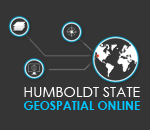Remote Sensing Basics
What is a Sensor?
A sensor detects physical variations in the world, for example light, temperature, radio waves, sound and magnetic fields. Examples of human senses are sight, sound, smell, touch and taste. Out of our senses, three are remote senses: sight, sound and smell. Our visual system is an excellent example of a remote sensing system. The photosensitive cells in our eyes known as the cones and the rods detect visible light. Another common sensor that everyone is familiar with is a camera. Similar to our eyes, cameras are also examples of remote sensors that detect and measure light.
Passive vs Active Remote Sensing
Platforms
In order for a sensor to collect and record the energy reflected or emitted from a target or surface, it must reside on a stable platform. There are a variety of platforms types. There are three main categories of platforms: Ground based, aerial and satellite platforms.
Ground Based Platforms
There are a variety of ground based platforms used in remote sensing. Ground based platforms can include sensors in hand held devices, sensors mounted on tripods and even on agricultural equipment. Sometimes ground based sensors are used to calibrate airborne and satellite acquired data.
Aerial Platforms
Aerial platforms include all platforms that are located above the Earth's surface. The most common type of aerial platforms are fixed-wing aircrafts. Sensors can also be mounted on helicopters, balloons and kites. Recently Unmanned Aircraft Systems or UAS are being used to collect remote sensed data. A UAS is any aircraft that does not have a pilot on board and is controlled remotely.
Satellite Platforms
Remote sensing satellites have been around for over 50 years and are used to measure a variety of phenomena. There are a wide variety of satellites that vary in size and orbit. Satellites allow for repeat coverage of the Earth's surface on a continuing basis.
